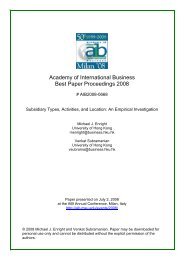AIB 2012 Conference Proceedings - Academy of International ...
AIB 2012 Conference Proceedings - Academy of International ...
AIB 2012 Conference Proceedings - Academy of International ...
Create successful ePaper yourself
Turn your PDF publications into a flip-book with our unique Google optimized e-Paper software.
TUESDAY<br />
The conventional approach in international business research is to consider and/or compute country distance as<br />
independent <strong>of</strong> individual and firm actions. Borrowing from Teece et. al. (1994), we propose in this paper an<br />
alternative approach that relies on ‘survivor' data culled from the very actions <strong>of</strong> these individuals and/or firms<br />
to compute ‘country relatedness', the inverse <strong>of</strong> distance. We then focus on country relatedness for investment<br />
decisions, defined as the degree to which there are economies to joint operations and/or ownership in these<br />
countries by a multinational enterprise (MNE). To test the predictive validity <strong>of</strong> country relatedness for<br />
investment decisions, we hypothesize that MNEs characterized by high levels <strong>of</strong> international coherence, the<br />
degree to which they operate in related countries, will have a superior performance. Our empirical test starts by<br />
computing country relatedness for 24,000 country pairs, using investment data for the full sample <strong>of</strong> 20,000<br />
public MNEs worldwide. We then measure international coherence for a sample <strong>of</strong> 1,000 U.S. MNEs and find<br />
support for our hypothesis and the validity <strong>of</strong> the measures proposed. (For more information, please contact:<br />
Sokol Celo, Suffolk University, USA: scelo@suffolk.edu)<br />
Making the Most <strong>of</strong> the Second Best: Synchronization <strong>of</strong> Reforms Rhythms, Slack, and Performance <strong>of</strong><br />
Transition Economy Firms<br />
Elitsa R. Banalieva, Northeastern University<br />
We analyze the understudied impact <strong>of</strong> synchronization <strong>of</strong> reforms rhythms on the performance <strong>of</strong> transition<br />
economy firms. We argue that higher synchronization <strong>of</strong> reforms rhythms improves the firms' performance due<br />
to timing synergies among the different reforms types. Additionally, we propose that excess high-discretion<br />
slack further strengthens the performance benefits from a higher synchronization <strong>of</strong> reforms rhythms because it<br />
allows the transition economy firms to more quickly adapt to their changing institutional environment. Thus, we<br />
extend the institution-based view <strong>of</strong> the firm by shifting its traditional focus on institutional differences across<br />
countries to a new research direction that accounts explicitly for the timing <strong>of</strong> implementation—concurrent or<br />
sequential—<strong>of</strong> the different types <strong>of</strong> reforms rhythms within a country over time. Our test on a sample <strong>of</strong> 430<br />
firms from 13 transition economies during 1991-2009 supports our arguments. (For more information, please<br />
contact: Elitsa R. Banalieva, Northeastern University, USA: e.banalieva@neu.edu)<br />
Session: 3.1.7 - Competitive<br />
Track: 9 - Cross-cultural Management and HRM<br />
Negotiation and Conflict Resolution Across Cultures<br />
Presented On: July 3, <strong>2012</strong> - 09:00-10:15<br />
Chair: Allan Bird, Northeastern University<br />
Business as Unusual: A Comparison <strong>of</strong> the Tactical Preferences <strong>of</strong> Chinese and Australian Negotiators<br />
Cheryl Rivers, Victoria University <strong>of</strong> Wellington<br />
Roger James Volkema, IAG/PUC-Rio<br />
How do Eastern and Western perceptions <strong>of</strong> questionable or unethical (tricky) negotiation tactics differ We<br />
address this question by comparing 161 Chinese and 146 Australian negotiators' ratings <strong>of</strong> appropriateness <strong>of</strong><br />
different types <strong>of</strong> negotiation tactics. We predict that their different cultural values and cultural differences in<br />
the implicit theories <strong>of</strong> how negotiation ought to be conducted will be salient in their perceptions <strong>of</strong> tactics.<br />
Rather than thinking about tricky tactics as a generic group, we explore differences in Chinese and Western<br />
negotiators' perspectives <strong>of</strong> different types <strong>of</strong> negotiation tactics. Awareness <strong>of</strong> The Secret Art <strong>of</strong> War: The 36<br />
Stratagems means Chinese negotiators think very differently about some types <strong>of</strong> tactics compared to Western<br />
negotiators who have no equivalent <strong>of</strong> the 36 stratagems in their tactic repertoire. We found Chinese<br />
negotiators rated tactics that are related to the 36 stratagems as significantly more appropriate than did<br />
Australian negotiators. Also, Australians were significantly more approving <strong>of</strong> tactics that use negative emotions<br />
<strong>AIB</strong> <strong>2012</strong> <strong>Conference</strong> <strong>Proceedings</strong><br />
Page 193

















